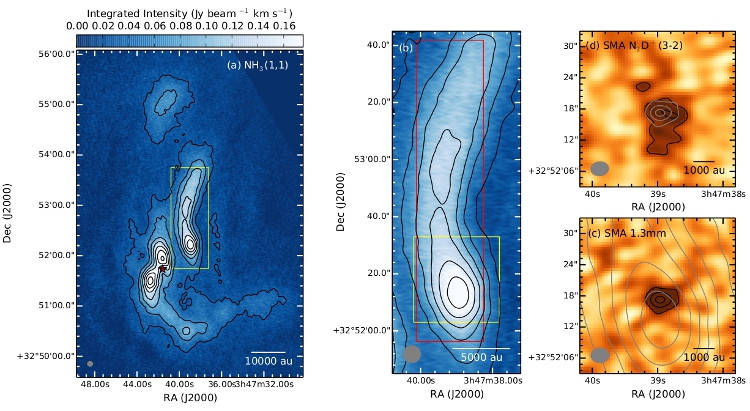| EPoS Contribution |
|
Turbulence dissipation and fragmentation in an isothermal filament: initial conditions for star formation
Jaime Pineda ETH Zurich, Zurich, CH | |
| Filamentary structures are found throughout star forming regions. However, it is not clear how these structures fragment to further allow star formation to proceed. Here, we present high angular resolution observations (~4arcsec) of the B5 region in Perseus obtained with the JVLA and SMA. The NH3 data covers the entire region of subsonic turbulence and the embedded isothermal filament, which allows us to determine the power-spectrum within the sonic region. This is the first time such a determination can be performed, and it can be compared with synthetic observations of simulations to determine how is the turbulence dissipated within the sonic scale. Moreover, the NH3 data shows fragmentation along the filament. Our SMA observations towards the most massive fragment (at the filament's tip) show the presence of a dust continuum source, with an estimated mass of 0.15Msun. The lack of a detected Spitzer source or outflow emission (from our simultaneous 12CO and 13CO SMA observations) suggest that there is no protostar formed yet. The SMA observations also revealed the presence of extended N2D+ (3-2) emission at the position of the dust continuum source. We calculate the velocity gradient and specific angular momentum from the NH3(1,1) and N2D+(3-2) data sets to study how is the angular momentum transported in the earliest stages of star formation, before a protostar is formed, and to compare it with previous observations. | |
 | |
| Caption: (a) NH3 (JVLA+GBT)integrated intensity map of Barnard 5. It shows the embedded filaments, while the yellow box shows the region shown in panel b. (b) Isothermal filaments in B5 shown in the integrated intensity NH3 map. Our SMA observations, marked by the yellow box, target the most massive fragment of them all. (c) SMA 1.3mm dust continuum (background and black contours) shows the presence of a compact source offset form the NH3 peak. (d) N2D+ (3-2) map observed with SMA reveals an extended object that aligns with the continuum source. | |
| Collaborators: A.A. Goodman, CfA, USA H. Arce, U. Yale, USA P. Caselli, U. Leeds, UK G. Fuller, U of Manchester, UK S. Corder, ALMA JAO/NRAO, Chile T. Bourke, SKA, UK |
Key publication
Suggested Sessions: Filaments |

